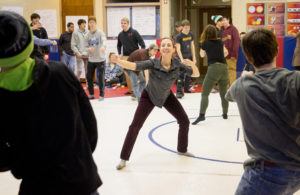
Jacob’s Pillow Curriculum in Motion® (JPCIM®) is a nationally-recognized, arts-integrated curricular approach that supports teaching and learning at three Berkshire County K-12 schools. Each two-week residency is co-taught by Artist Educators in collaboration with classroom teachers.
In 2016, Jacob’s Pillow staff member Chelsea Zibolsky sat down with Artist Educators Margot Greenlee and Elizabeth Johnson during their December residency to discuss the impact they witness in the classroom.
A glimpse into our December 2016 residency as students begin to problem solve collaboratively, and transform familiar classrooms into moving spaces.
How does dance inspire understanding of the materials being taught?
EJ: Dance in this form is embodied learning. It is used as a way to reflect, remember and recreate the knowledge that is in the curriculum. Sometimes it is about physical modeling, for example when I work in a science classes and we look at something like covalent bonds verses hydrogen bonds. They can visually represent those ideas by demonstrating mutual dependence and weight sharing.
In other kinds of classes we are really getting at concepts instead of the nuts and bolts. For example, in English class we have nine folks who are looking at the novella Seedfolks through the lens of a concept: connecting across differences. It is a way to take the theme in the book and deepen their understanding by bringing themselves into the work.
This approach to learning is using our whole selves. Our mind and our body connected through our central nervous system to gain understanding, and to engage students more thoroughly in their own learning.
Elizabeth Johnson
MG: Anytime you make a dance about something you remember it long term, because you are using every cell in your body. That is just the way humans are built, to remember experiences, conversations and connections with other people.
Students get physical during our December 2016 residency warm-up, while Jacob’s Pillow Artist Educator, Elizabeth Johnson, exchanges ideas with MMRHS teacher, Mike Mooney, during teacher and artist co-planning.
As the materials are being taught what are you seeing in the students?
EJ: I think that especially in high school there are so many social and emotional dynamics at work. The idea of identity building–those things get cast early on in life, especially in a town where a lot of kids come up from kindergarten all the way through high school with the same cohort of students. The ways we come to know ourselves and others are illuminated in this kind of work, in a different way than when everyone is in their own desk facing the same direction.
I believe a huge component of this work is not only about understanding the curriculum, but also about the ways that we build community in a classroom.
Elizabeth Johnson
What are some challenges you face in the classroom?
EJ: The very same things that are the benefits of this work are also the challenges of this work, because it uses our whole selves it inevitably makes us vulnerable. We cannot have connection without vulnerability though. This teaches us skills in allowing ourselves to expand our range and our access to our full selves into the room. It is a benefit that it makes one vulnerable, because it allows for greater connection. It is scary to be vulnerable. So how we build the safety and the bravery in the room is very important. Some of the ways that we do that from day one are first to use some of the knowledge in the room, and recognize that.
What are some takeaways for the students? How can they translate these into their lives?
MG: Students and teachers report that weeks and months after we have worked together students are still able to recall very specific details. They are able to distinguish between concepts and ideas that normally are difficult for them to keep separate.
We always ask them at the end, how can you use this way of working in another part of your life? We get some really cool answers; from some sort of a sports connection; to using movement to remember Spanish verbs.
In this type of work, our goal is to help everybody do their best, that day and that moment.
My hope, and I have many, but I would say the earlier students can figure out the ways they can learn best, the better off they are going to be.
That is just the way humans are built, to remember experiences, conversations and connections with other people.
Margot Greenlee
A short variety of moments displaying collective student embodiment that highlights increased comfort, play, and confidence in students over the course of a residency!
All videos by Alivia Schaffer.
Curriculum in Motion
During the school year, Jacob’s Pillow Curriculum in Motion®, a nationally-recognized arts-integrated curricular approach.